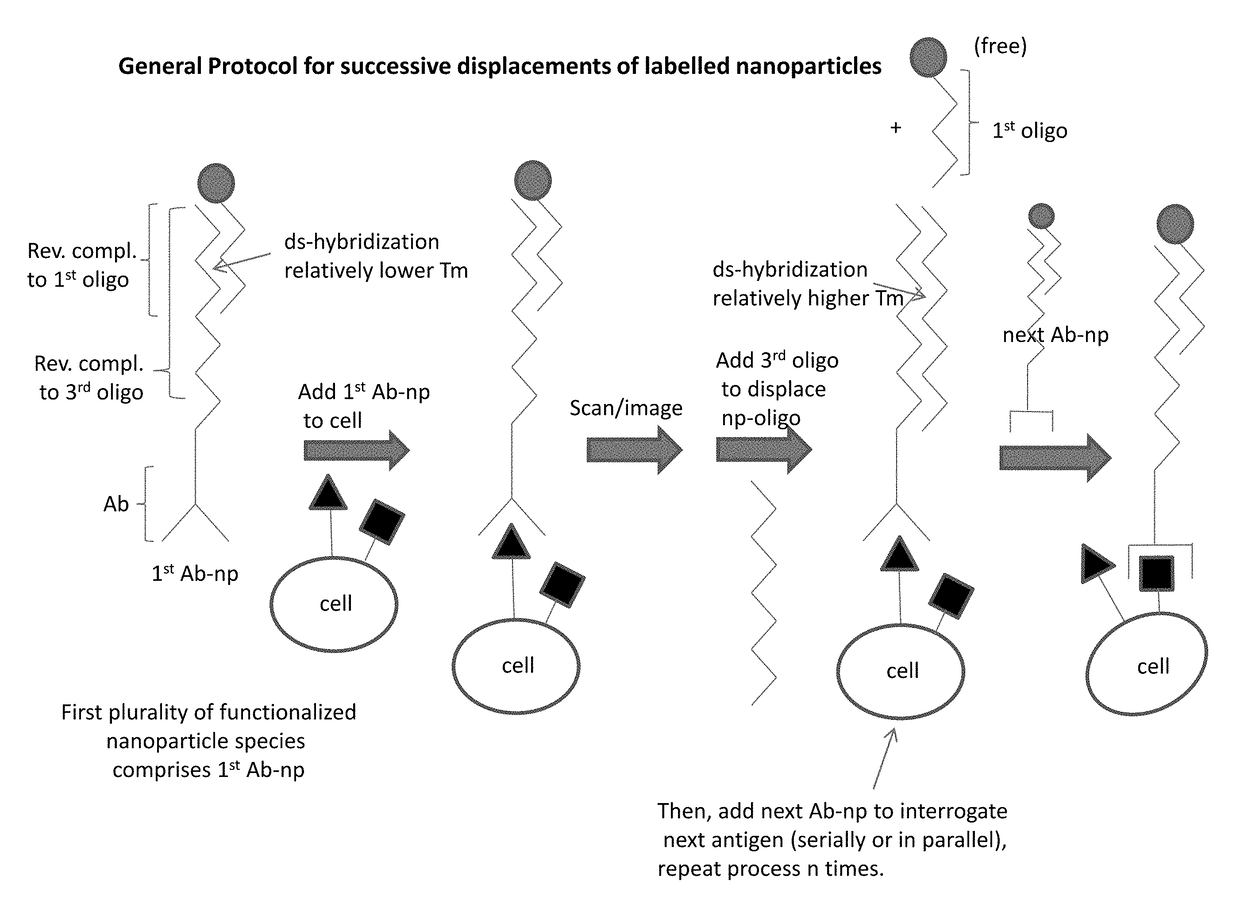Integrated visual morphology and cell protein expression using resonance-light scattering
a cell protein and resonance light scattering technology, applied in the field of integrated visual morphology and cell protein expression analysis, can solve the problem of insufficient morphological analysis to diagnose, and achieve the effect of enhancing the ability to diagnose and monitor
- Summary
- Abstract
- Description
- Claims
- Application Information
AI Technical Summary
Benefits of technology
Problems solved by technology
Method used
Image
Examples
example 1
Cell Labeling for Simultaneous Detection of Morphology and Phenotyping
[0322]As a non-limiting example of detecting the biomarker-morphology profile of a cell, cells were labeled with α-CD4 (BD #555344) and α-CD8 (BD#555631) nanoparticles. Other combinations of antibodies described herein and nanoparticles described herein can be used to detect the cell biomarker-morphology profile.
[0323]Coating Particles with Antibody—
[0324]Particles were first concentrated by centrifuging 1.0 ml of 150 nm Au particles (Cytodiagnostics# G150-20) to 100 μl at 800×g for five minutes, and separately, one ml of 100 nm Ag particles (NanoComposix# ECP1095) to 100 ul at 1200×g for five minutes. Particles were resuspended by sonication and followed by an addition of 500 μl (microliters) of 5 mM Sodium Bicarbonate. Particles were concentrated again to 100 μl (microliters) by centrifugation and resuspended by sonication.
[0325]To the Au and Ag concentrated particles, 20 ul of α-CD4 and α-CD8 were added, respec...
example 2
[0330]Labeled cells were spread by applying 2 μl of the cell suspension to a glass slide in an area of 1 cm2 and dried for five minutes. To fix cells, the slide was soaked in a Coplin Jar with 100% MeOH for five minutes. The slide was transferred to a tube containing diluted 1:20 Giemsa stain (Ricca Chemical #3250-16) in water for one minute. The slide was washed with water to remove excess stain and allowed to air dry. Other stains, as disclosed herein may be used to stain cells.
[0331]FIG. 9 shows an initial Brightfield image of Giemsa stained cells imaged for morphology detection in Bright-Field using 20× objective, Olympus BX60M microscope and DP71 color camera.
[0332]The cells were then destained as follows: Destain solution, pH 11.3, was prepared by adding 50 μl (microliters) of 100 mM sodium phosphate to one mL of 60% MeOH / 40% Glycerol. 500 μl of destain was added to slide, incubated for 30 seconds, and washed with water. Before imaging, 411 DPX mountant...
example 3
3 Color Multiplexing
[0333]This example demonstrates the ability to detect functionalized nanoparticles comprising three different nanoparticles. To 0.2 mL of 1 OD particles, addition of 10 μl of 20 mM CTPEG mixtures (Nanocs# PG2-CATH-10k) was made to yield approximately 1 mM PEG. CTPEG mixtues are thiol carboxylic acid functionalized PEG, Molecular Weight of 10000. After 30 minute incubation at room temperature, 0.1% w / v Pluronic® F127 (BASF#51181981) was added and allowed to stand for an additional 30 minutes. Pluronic® block copolymers are synthetic copolymers of ethylene oxide and propylene oxide represented by the following chemical structure: HO(C2H4O)101(C3H6O)56(C2H4O)101H. Particles were centrifuged at 3000×g for 10 minutes and resuspended in 200 μl mM MES, pH 6, 0.1% F127. Next, 10 mg of concentrated EDC (Thermo#77149) in distilled water was dissolved in one mL 5 mM MES, pH 6, 0.1 F127 to yield 52 mM. An addition of 11.5 μl (microliters) of 52 mM EDC solution was made to yi...
PUM
 Login to View More
Login to View More Abstract
Description
Claims
Application Information
 Login to View More
Login to View More - R&D
- Intellectual Property
- Life Sciences
- Materials
- Tech Scout
- Unparalleled Data Quality
- Higher Quality Content
- 60% Fewer Hallucinations
Browse by: Latest US Patents, China's latest patents, Technical Efficacy Thesaurus, Application Domain, Technology Topic, Popular Technical Reports.
© 2025 PatSnap. All rights reserved.Legal|Privacy policy|Modern Slavery Act Transparency Statement|Sitemap|About US| Contact US: help@patsnap.com



